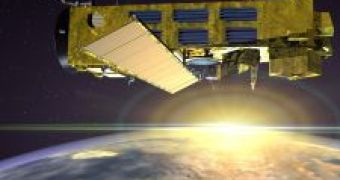ESA's Envisat satellite is already starting to give headaches to the agency as in three years it will be an out-of-use-11-year-old space debris. This 17,636-pound Earth observation satellite launched in 2002 was the biggest non-military observation satellite ever built. It was highly expensive at $2.9 billion but very successful, and its mission extended from 5 to 11 years.
At the 38th Congress of the Committee on Space Research (Cospar), July 18-25, space debris experts gave an example of how dangerous Envisat can be, by citing the January avoided impact between an upper stage from a Chinese rocket and the satellite. As the satellite was still operational, ESA's European Space Operations Center (ESOC) control facility in Darmstadt, Germany could make a collision avoidance maneuver. The problem that the future poses is that once Envisat is retired, maneuvering it will become impossible.
This satellite also has a specific configuration in orbit. Its dimensions are 26 meters by 10 meters by 5 meters in orbit, which means that even a small piece of debris could cause a “fragmentation event” and cause space junk. Calculations suggest that there are 15 to 30 percent chances that Envisat will collide with another space junk in the 150 years which would be necessary for it to be attracted by the Earth's atmospheric drag. This, of course, if all launch into space is stopped until then, which is an absurd hypothesis.
Either way, Envisat program managers said that the satellite was originally built with a French Spot 4 fuel tank and any attempt to bring it down enough for the atmosphere to pull it in would have meant retiring it a few months after launch.
Even if ESA officials insist that the international guidelines on disposal of debris did not exist when Envisat was designed, the problem is that it is too big to just be left floating into space. European space safety rules say that any space hardware that might survive atmospheric re-entry must be guided, so that it lands in an uninhabited area, like the South Pacific Ocean for example.
Jurgen Starke of Astrium Space Transportation, a company is under ESA contract to study debris removal technologies, says that it is not sure yet whether is better to raise the satellite to an orbit currently unused or to guide it into the Pacific Ocean. In any case, mission costs will be of millions of dollars and at the time, neither possibility is approved by the ESA governments, according to space.com.

 14 DAY TRIAL //
14 DAY TRIAL //